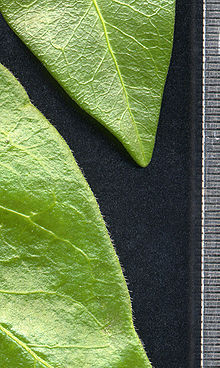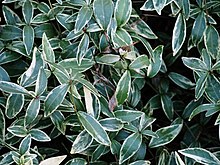| Vinca minor | |
|---|---|

| |
| Scientific classification | |
| Kingdom: | Plantae |
| Clade: | Tracheophytes |
| Clade: | Angiosperms |
| Clade: | Eudicots |
| Clade: | Asterids |
| Order: | Gentianales |
| Family: | Apocynaceae |
| Genus: | Vinca |
| Species: | V. minor |
| Binomial name | |
| Vinca minor L. | |
Vinca minor (common names lesser periwinkle or dwarf periwinkle) is a species of flowering plant in the dogbane family, native to central and southern Europe. Other vernacular names used in cultivation include small periwinkle, common periwinkle, and sometimes in the United States, myrtle or creeping myrtle.
Description

Vinca minor is a trailing subshrub, spreading along the ground and rooting along the stems to form large clonal colonies and occasionally scrambling up to 40 centimetres (16 in) high but never twining or climbing. The leaves are evergreen, opposite, 2–4.5 cm (3⁄4–1+3⁄4 in) long and 1–2.5 cm (1⁄2–1 in) broad, glossy dark green with a leathery texture and an entire margin.
The flowers are solitary in the leaf axils and are produced mainly from early spring to mid summer but with a few flowers still produced into the autumn; they are violet-purple (pale purple or white in some cultivated selections), 2–3 cm (3⁄4–1+1⁄4 in) diameter, with a five-lobed corolla. The fruit is a pair of follicles 2.5 cm (1 in) long, containing numerous seeds.
Chemistry
Vinca minor contains more than 50 alkaloids, including vincamine. Other alkaloids include reserpine, rescinnamine, akuammicine, majdine, vinerine, ervine, vineridine, tombozine, vincamajine, vincanine, vincanidine, vinburnine, apovincamine, vincaminol, desoxyvincaminol, vincorine and perivincine.
Similar species
The closely related Vinca major is similar, but larger in all parts, and also has relatively broader leaves with a hairy margin.
Distribution and habitat
Vinca minor is native to central and southern Europe, from Portugal and France north to the Netherlands and the Baltic states, east to the Caucasus, and also southwestern Asia in Turkey.
Invasiveness
It is considered an invasive species in some areas of the United States, primarily because of its ability to form dense and extensive mats along the forest floor, displacing native herbaceous and woody plant species.
The species has few pests or diseases outside its native range and is widely naturalized as a result. Invasion can be restricted by removal of rooting stems in spring. Once established, it is difficult to eradicate, as its waxy leaves shed most water-based herbicide sprays. Spraying with glyphosate easily kills the plant in 2–3 weeks. Removal involves cutting, followed by immediate application of concentrated glyphosate or triclopyr to the cut stems. Repeated chemical treatments may be necessary, along with digging up the roots where feasible.
Cultivation
The species is commonly grown as a groundcover in temperate gardens for its evergreen foliage, spring and summer flowers, ease of culture, and dense habit that smothers most weeds. It was once commonly planted in cemeteries in parts of the Southern U.S. and naturalized periwinkle may indicate the presence of graves whose other markers have disappeared.
Cultivars

There are numerous cultivars, with different flower colours and variegated foliage. Many have a less vigorous habit than the species, and are therefore more suitable for smaller gardens. The following cultivars have gained the Royal Horticultural Society's Award of Garden Merit:
- 'Argenteovariegata' (leaves have creamy white margins)
- 'Atropurpurea' (burgundy-purple flowers)
- 'Azurea Flore Pleno' (double blue flowers)
- 'Bowles's Variety' (violet-blue flowers: also known as 'Bowles's Blue' and 'La Grave')
- 'Ralph Shugert'
Uses
Vinpocetine (brand names: Cavinton, Intelectol; chemical name: ethyl apovincaminate) is a semisynthetic derivative alkaloid of vincamine with purported medicinal uses.
In culture
The colour name periwinkle is derived from the flower.
References
- BSBI List 2007 (xls). Botanical Society of Britain and Ireland. Archived from the original (xls) on 2015-06-26. Retrieved 2014-10-17.
- Foster, Rachel. "So Many Myrtles — Unraveling the confusion and contradiction". Archived from the original on April 12, 2008. Retrieved December 2, 2019.
- Khanavi, M.; Pourmoslemi, S.; Farahanikia, B.; Hadjiakhoondi, A.; Ostad, S. N. (2010). "Cytotoxicity ofVinca minor". Pharmaceutical Biology. 48 (1): 96–100. doi:10.3109/13880200903046187. PMID 20645762. S2CID 42993549.
- Tulyaganov, T. S.; Nigmatullaev, A. M. (2000). "Alkaloids of Vinca minor". Chemistry of Natural Compounds. 36 (5): 540. Bibcode:2000CNatC..36..540T. doi:10.1023/A:1002820414086. S2CID 45597272.
- Smeyers, Y. G.; Smeyers, N. J.; Randez, J. J.; Hernandez-Laguna, A.; Galvez-Ruano, E. (1991). "A structural and pharmacological study of alkaloids of Vinca Minor". Molecular Engineering. 1 (2): 153. doi:10.1007/BF00420051. S2CID 93210480.
- Yasui, Y.; Kinugawa, T.; Takemoto, Y. (2009). "Synthetic studies on vincorine: Access to the 3a,8a-dialkyl-1,2,3,3a,8,8a-hexahydropyrrolo\2,3-b]indole skeleton". Chemical Communications (28): 4275–7. doi:10.1039/b907210a. PMID 19585045.
- Farnsworth, N. R.; Draus, F. J.; Sager, R. W.; Bianculli, J. A. (2006). "Studies on Vinca major L. (Apocynaceae) I. Isolation of perivincine". Journal of the American Pharmaceutical Association. 49 (9): 589. doi:10.1002/jps.3030490908.
- "common periwinkle: Vinca minor (Gentianales: Apocynaceae): Invasive Plant Atlas of the United States". www.invasiveplantatlas.org. Retrieved 2024-04-04.
- "Texas Invasives". www.texasinvasives.org. Retrieved 2024-04-04.
- "Periwinkle (Vinca Minor)". Master Gardeners of Northern Virginia. 2021-11-17. Retrieved 2024-04-04.
- Hobbs, Holly (2012-11-20). "Preservation group discovers Fairfax County's past as it cleans up graves". Washington Post.
- "AGM Plants - Ornamental" (PDF). Royal Horticultural Society. July 2017. p. 107. Retrieved 18 February 2019.
- "Vinca minor Argenteovariegata". RHS. Retrieved 17 March 2021.
- "Vinca minor Atropurpurea". RHS. Retrieved 17 March 2021.
- "Vinca minor 'Azurea Flore Pleno'". RHS. Retrieved 17 March 2021.
- "Vinca minor 'Bowles's Variety'". RHS. Retrieved 19 February 2019.
- "Vinca minor 'Ralph Shugert'". RHS. Retrieved 5 March 2021.
- Zhang YS, Li JD, Yan C (January 2018). "An update on vinpocetine: New discoveries and clinical implications". European Journal of Pharmacology. 819: 30–34. doi:10.1016/j.ejphar.2017.11.041. PMC 5766389. PMID 29183836.
Further reading
- Flora Europaea: Vinca minor distribution
- Morphology and ecology of Vinca minor (in Spanish)
- Borealforest: Vinca minor
- Vinca minor (from Ohio State University's Pocket Gardener)
- Common periwinkle (as an invasive species; includes photos)
- Blamey, M., & Grey-Wilson, C. (1989). Flora of Britain and Northern Europe. Hodder & Stoughton.
- Huxley, A., ed. (1992). New RHS Dictionary of Gardening 4: 665. Macmillan.
- detailed technical description
- Encyclopedia of Life database entry
External links
- Traditional Medicine Uses: Vinca minor
- "Vinca minor". Plants for a Future.
- "Vinca minor". Calflora. Berkeley, California: The Calflora Database.
- Vinca minor in the CalPhotos photo database, University of California, Berkeley
| Taxon identifiers | |
|---|---|
| Vinca minor |
|

